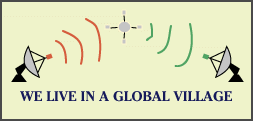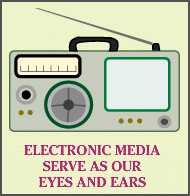
 TUTORIAL: Communication Environment
TUTORIAL: Communication EnvironmentINTRODUCTION . THE COMMUNICATION ENVIRONMENT . COMMUNICATION AND CULTURE . THE SOCIAL CONSTRUCTION OF REALITY . IDEOLOGY . TECHNOLOGY
There is little doubt that technology is an important aspect of the communication environment, but there is considerable dispute as to the proper scope of the term "technology". In the words of scholar Raymond Williams
...[P]eople often speak of a new world, a new society, a new phase of history, being created - 'brought about' - by this or that new technology: the steam-engine, the automobile, the atomic bomb. Most of us know what is generally implied when such things are said. But this may be the central difficulty: that we have got so used to statements of this general kind, in our most ordinary discussions, that we can fail to realize their specific meanings.
For behind all such statements lie some of the most difficult and most unresolved historical and philosophical questions. Yet the questions are not posed by the statements; indeed they are ordinarily masked by them. Thus we often discuss, with animation, this or that 'effect' of television, or the kinds of social behavior, the cultural and psychological conditions, which television has 'led to', without feeling ourselves obliged to ask whether it is reasonable to describe any technology as a cause ....
- Williams 10
Given this situation, we should not be surprised that there is much misunderstanding of and debate about the nature of human technology. Perhaps the most widely accepted viewpoint is known as technological determinism. This view asserts that human beings are naturally curious creatures who are driven to explore and invent. As the new technologies that result from these explorations and inventions become widely known and available for use, they bring about changes in the daily lives of the people who use them.
![]() 1501
1501
![]() 1502
1502
This view is deterministic because it implies that technology is an inescapable part of human life -- humans can learn to live with their technologies, or at least they can try to, but they cannot stop themselves from inventing technologies. Theories of technological determinism range from pure pessimism -- the opinion that technology will eventually result in the destruction of the human race -- to pure optimism -- the opinion that humans will eventually create technologies that lead to a utopian existence for everyone.
Many books have been written from these and other points of view, and, of course, there is not sufficient time to review all of them here. Instead, this tutorial highlights the work of four scholars who have contributed to the study of technology and human communication. Harold Innis, Marshall McLuhan, Walter Ong, and Elizabeth Eisenstein have been chosen because their work is interrelated, and because it demonstrates the process by which communication scholars develop their opinions and explanations.
 Innis argues that communication media play a significant role in the overall organization of a society because the dominant media of expression influence the kinds of human relationships that can develop among the members of the society. In this regard he divides media into two categories, time-binding and space-binding.
Innis argues that communication media play a significant role in the overall organization of a society because the dominant media of expression influence the kinds of human relationships that can develop among the members of the society. In this regard he divides media into two categories, time-binding and space-binding.
Time-binding media tend to focus the attention of the society on its past. Such societies are often controlled by strong philosophical or religious institutions, are very concerned with preserving their traditional way of life, are not open to change, and are usually not very interested in conquest and expansion.
Speech is an example of a time-binding medium. Societies whose only means of communication is the spoken word cannot communicate accurately over long distances, nor do they have access to printed record-keeping. This limits their ability to establish far-ranging governmental institutions. Members of such societies tend not to travel very much, or very far, and most people's daily lives are focused on family and religious traditions - the past is a very important part of everyday life.
Space-binding media tend to focus the attention of a on its borders. Such societies are often organized by means of a central, non-religious government. Rather than traditions, such societies have laws which are written down and subject to change. These societies are inclined to expand by means of trade or conquest. At least some members of the society travel frequently. In such a society day-to-day life is concerned with the present and the future - with politics and economics and "improving oneself."
 Print is an example of a space-binding medium. When traditions can be written down, they become "laws." Everyone who can read has access to the laws, and everybody notices when they change. Print encourages the development of economic institutions such as banks and trading companies, and also the development of bureaucratic government. These tend to focus attention on economic growth and on the "state."
Print is an example of a space-binding medium. When traditions can be written down, they become "laws." Everyone who can read has access to the laws, and everybody notices when they change. Print encourages the development of economic institutions such as banks and trading companies, and also the development of bureaucratic government. These tend to focus attention on economic growth and on the "state."
Innis proposes a process by which the development of new media encourages change. Within a society the dominant medium of communication will be controlled by the dominant political group who will use the media to support the ideas and beliefs of the dominant group and make all others illegitimate. In this situation, the appearance of a new media of communication provides a vehicle by which those opposed to the dominant group could initiate social change. An example of this is the use of the printing press by the Protestant Christians in opposition to the hegemony of the Roman Catholic Church during the Protestant Reformation.
![]() Changes in ancient Egyptian civilization
Changes in ancient Egyptian civilization
Innis's ideas became the starting point for a number of other communication scholars. Marshall McLuhan extended Innis's concept of social change; Elizabeth Eisenstein investigated the effect of the development of printing on the social structure of Europe in the late-15th century; and Walter Ong explored the ways in which oral and literate societies construct their social realities.
![]() 1525
1525
![]() 1526
1526
Marshall McLuhan's genius for phrase-making (among his creations: The Medium is the Message, The Global Village, Hot and Cool media, radio as The Tribal Drum...) made him something of a phenomenon in the late 1960s when he was treated in the news media as a prophet of the coming electronic age. Although his writing is sometimes difficult to decode, he was responsible for a dramatic shift in the way we view technology. In the words of Walter Ong
McLuhan attracted the attention not only of scholars but also of people working in the mass media, of business leaders, and of the generally informed public, largely because of fascination with his many gnomic or oracular pronouncements, too glib for some readers, but often deeply perceptive. ...Few people have had so stimulating an effect as Marshall McLuhan on so many diverse minds, including those who disagreed with him or believed they did.
- Ong 29
Although McLuhan built on the ideas of Innis, he took a very different approach to the study of media. Whereas Innis focused on the role of media in shaping the overall structure of society, McLuhan focused on the ways that different media might affect people's sensory perceptions. McLuhan's work is difficult to summarize, however, his main argument asserts that all technologies are extensions of the human body -- the automobile is an extension of the legs, the hammer is an extension of the arm, eyeglasses are extensions of the eyes, the telephone is an extension of the voice and the ear, and so on. This model of human technology produces original and intriguing observations, including, for example, that:
This latter assertion may be the most significant of McLuhan's insights. When he says, "The medium is the message," he agrees with Innis that a society's choice of communication media greatly influences its social organization. However, McLuhan extends Innis's concept to suggest that the media in use within a society affect its members at the level of the individual. Each of us must communicate via the available media, says McLuhan, and as these media make different demands on our senses, they directly affect our concepts, and through these our social reality.

This assertion is still being debated, but there is evidence that might be taken to support McLuhan's claim. In today's United States if people want to "get in touch" with one another, they seldom write letters - they pick up the telephone and make a call. The growing use of portable and cellular phones is well documented, and as in the medieval village, one need never be "out of touch."

For example, within the United States there is a growing debate as to whether "access to information media" is the right of every citizen. Our society already believes that access to water, sewer and power facilities is so important that we have declared these to be government regulated public utilities.
 Some people argue that as more and more services are carried out via cable systems and computer networks, that these, too, should be regulated as public utilities. The debate on this issue involves questions about public access to public information, the right to privacy, the cost of setting up "information utilities" and so on. This issue is important not only to those who might be denied access, but also to media organizations who might be subject to government regulation in the future.
Some people argue that as more and more services are carried out via cable systems and computer networks, that these, too, should be regulated as public utilities. The debate on this issue involves questions about public access to public information, the right to privacy, the cost of setting up "information utilities" and so on. This issue is important not only to those who might be denied access, but also to media organizations who might be subject to government regulation in the future.
Perhaps the best way to encounter McLuhan is to read his books and think about his observations and comments. Question #1503 presents a series of quotations from Understanding Media for your consideration.
Ong asks a very interesting question - what would life be like in a society that has no ability to write. Ong calls such a society a "primary oral society," and his analyses of what he calls "the characteristics of orally based thought" provide much insight into this aspect of the communication environment.
In his book Orality and Literacy Ong points out that it is very difficult for people such as ourselves - people who live in a chirographic society - to imagine what life would be like without writing. This section summarizes some of his observations.
Try to imagine a culture in which no one has ever 'looked up' anything. In a primary oral culture, the expression 'to look up something' is an empty phrase: it would have no conceivable meaning.
- Ong 31
Participants in a culture that surrounds them with the artifacts of writing seldom think of the importance of such documents as dictionaries, indices, charts and tables. But these are very important to the life of the society. For example, if a society had no way of writing down the words in its vocabulary how would it keep track of them?
Webster's Third New World Dictionary (1971) states in its Preface that it could have included 'many times' more than the 450,000 words it does include. Assuming that 'many times' must mean at least three time, and rounding out the figures, we can understand that the editors have on hand a record of some million and a half words used in print in English. Oral languages and oral dialects can get along with perhaps five thousand words or less.
- Ong 107
Suppose that a modern society decided to eliminate 90% of the words in its dictionary? How would that change the lives of the people? As difficult as it is to imagine this, the development of writing brought other, more subtle, changes.
Print created a new sense of the private ownership of words. Persons in a primary oral culture can entertain some sense of proprietary rights to a poem, but such a sense is rare and ordinarily enfeebled by the common share of lore, formulas, and themes on which everyone draws. With writing, resentment at plagiarism begins to develop.
- Ong131
Spoken words cannot be seen, and they cease to exist soon after they are spoken. Writing encouraged people to think of words as physical objects, and for the first time it became possible to imagine that people "owned" their words.
Lacking the ability to keep records, oral peoples have to constantly repeat the things that are most important to them.
Since in a primary oral culture conceptualized knowledge that is not repeated aloud soon vanishes, oral societies must invest great energy in saying over and over again what has been learned arduously over the ages.
- Ong 41
 Notice how this ties in with Innis' notion of time-binding media.
With the advent of writing a culture's history and its rules can be recorded, and more importantly, easily edited.
Notice how this ties in with Innis' notion of time-binding media.
With the advent of writing a culture's history and its rules can be recorded, and more importantly, easily edited.
Corrections in oral performance tend to be counterproductive, to render the speaker unconvincing. So you keep them to a minimum or avoid them altogether. In writing, corrections can be tremendously productive, for how can the reader know they have ever been made?
- Ong 104
With written records, however, different versions can be compared, corrections made, new ideas criticised. In this way the development of writing promotes change.
 ...oral memorization is subject to variation from direct social pressures. Narrators narrate what audiences call for or will tolerate. When the market for a printed book declines, the presses stop rolling but thousands of copies may remain.
...oral memorization is subject to variation from direct social pressures. Narrators narrate what audiences call for or will tolerate. When the market for a printed book declines, the presses stop rolling but thousands of copies may remain.
- Ong 66
No one is able to take a copy of the presentation home for later review. Consequently, those who were there have the sense of having participated in a unique event. Writing brings into existence the role of the "reader" -- a person who is able to imagine having attended the event from a distance.
Writing separates the knower from the known and thus sets up conditions for 'objectivity,' in the sense of personal disengagement or distancing.
- Ong 105
Writing also brings into existence the role of the "author" -- someone who is not present at the event and who therefore can speak without regard for the needs of the audience.
There is no way to directly refute a text. After absolutely total and devastating refutation, it says exactly the same thing as before. this is one reason why 'the book says' is popularly tantamount to 'it is true'. It is also one reason why books have been burnt.
- Ong 79
In the total absence of any writing, there is nothing outside the thinker, no text, to enable him or her to produce the same line of thought again or even to verify whether he or she has done so or not.
- Ong 34
This means that oral societies do not "think" in the same ways that literate societies do.
...an oral culture simply does not deal in such items as geometrical figures, abstract categorization, formally logical reasoning processes, definitions, or even comprehensive descriptions, or articulated self-analysis, all of which derive not simply from thought itself but from text-formed thought.
- Ong 55
In other words, oral and literate societies operate by means of different logics. Writing gives us a different way of looking at the world -- indeed, a different reality.
![]() 1520
1520
To say writing is artificial is not to condemn it but to praise it. Like other artificial creations and indeed more than any other, it is utterly invaluable and indeed essential for the realization of fuller, interior, human potentials. Technologies are not mere exterior aids but also interior transformations of consciousness, and never more than when they affect the word. Such transformations can be uplifting. Writing heightens consciousness. Alienation from a natural milieu can be good for us and indeed is in many ways essential for full human life. To live and to understand fully, we need not only proximity but also distance. This writing provides for consciousness as nothing else does.
- Ong 82
...McLuhan raised a number of questions abut the actual effects of the advent of printing. They would have to be answered before other matters could be explored. What were some of the most important consequences of the shift from script to print? Anticipating a strenuous effort to master a large literature, I began to investigate what had been written on this obviously important subject. To my surprise, I did not find even a small literature available for consultation. No one had yet attempted to survey the consequences of the fifteenth-century communications shift.
- Eisenstein x
Eisenstein's research deals with the impact of the newly developing medium of print on the societies of Western Europe at the close of the Medieval period. She begins with an investigation of the establishment of printing presses in the Rhineland area of Germany in the 1460s, traces the rapid expansion of presses throughout Western Europe and the changes that this brought to the scribal culture of the time, and then identifies a number of social transformations that followed the advent of printing.
To set the scene, recall that it was in 1431 that Joan of Arc was burned at the stake, and in 1453 that the Turks captured Constantinople, which they then named Istanbul, thus ending the reign of the Eastern Roman Empire. Columbus had not yet sailed, and the Spanish Inquisition was not yet under way. This period of time, which we mark as the end of the Middle Ages and the beginning of the Renaissance, was to give birth to tremendous social change. Eisenstein's work shows that the development of print was an important factor in shaping that change. This section summarizes some of her conclusions.
Although the anti-Turkish crusade was thus the "first religious movement" to make use of print, Protestantism surely was the first fully to exploit its potential as a mass medium. It was also the first movement of any kind, religious or secular, to use the new presses for overt propaganda and agitation against an established institution. By pamphleteering directed at arousing popular support and aimed at readers who were unversed in Latin, the reformers unwittingly pioneered as revolutionaries and rabble rousers.
-Eisenstein 145
Although the wars that followed were perhaps the most dramatic evidence of the Protestants' successful propaganda campaign, many other religious changes were initiated by the presence of print. Bibles, which previously had been available only to those trained in Latin, were translated into local languages and reproduced at will.
In Europe the different Christian churches reacted differently to this -- the Protestants by accepting the notion the Bible should be read by individuals in their own languages, and the Roman Catholics by declaring that only the one, official, Latin version could be accepted as true. This situation led inevitably to other changes in the rituals and routines of Christian worship, eventually bringing about major changes in religious practice.
It was not only the craftsman outside universities who profited from the new opportunities to teach himself. Of equal importance was the chance extended to bright undergraduates to reach beyond their teachers' grasp. Gifted students no longer needed to sit at the feet of a given master in order to learn a language or academic skill. Instead, they could swiftly achieve master on their own....
 The push to make the written word available to people in their own languages impacted first on the most highly educated members of the society.
The push to make the written word available to people in their own languages impacted first on the most highly educated members of the society.
- Eisenstein 34
As reading became more important, more people learned to read. Eventually, this gave rise to the belief that the skill of reading is essential to the social health of the nation. The need to teach everyone how to read is one of the forces that produced generalized public education for all citizens.
Who could ascertain precisely what was known - either to prior generations within a given region or to contemporary inhabitants of far-off lands?... Exact determination must have been impossible before printing. Progressive refinement of certain arts and skills could and did occur. But no sophisticated technique could be securely established, permanently recorded, and stored for subsequent retrieval. Before trying to account for an "idea" of progress, we might look more closely at the new dynamic process entailed in a continuous accumulation of fixed records. Permanence introduced a new form of progressive change. The preservation of the old, in brief, was a prerequisite for a tradition of the new.
- Eisenstein 86
 With no way of keeping extensive records, and no way of transmitting large amounts of information over distances, oral societies do not develop scientific and industrial infrastructures. However, as records began to accumulate in Europe after the invention of print, theorists gained the ability to "compare notes." This was particularly effective with regard to scientific research - a method that depends on constant review of recorded data.
With no way of keeping extensive records, and no way of transmitting large amounts of information over distances, oral societies do not develop scientific and industrial infrastructures. However, as records began to accumulate in Europe after the invention of print, theorists gained the ability to "compare notes." This was particularly effective with regard to scientific research - a method that depends on constant review of recorded data.
Similarly, as craftsmen could now try out new ways of building things and pass the ideas that worked on to others. Thus, scientific investigation and technological development accelerated. The ability to record astrological and geographical observations, in the form of charts and maps, promoted the growth of science and of exploration of new lands. Thus, the development of literacy led to the industrial revolution and the European discovery of distant lands.
![]() 1527
1527
![]() 1528
1528
![]() 1529
1529
![]() 1538
1538
![]() 1539
1539
![]() 1540
1540
![]() 1551
1551